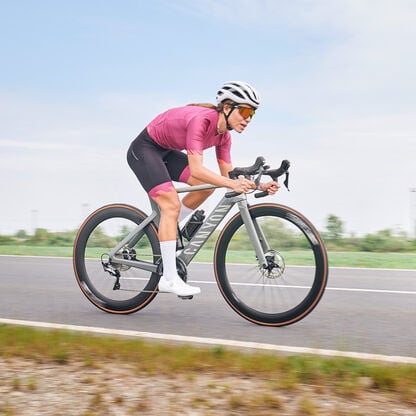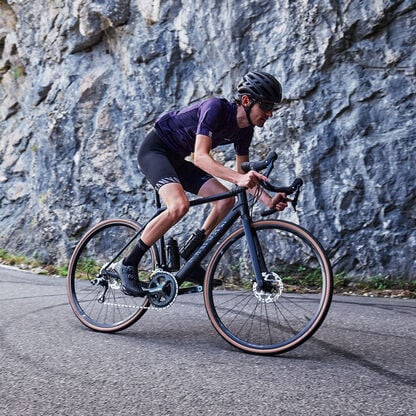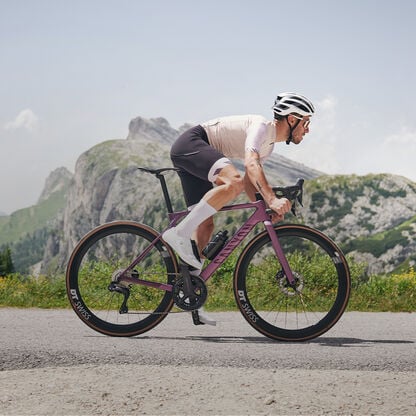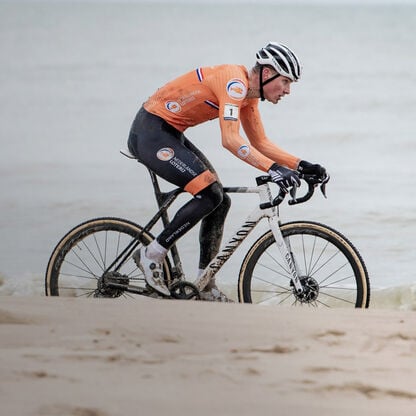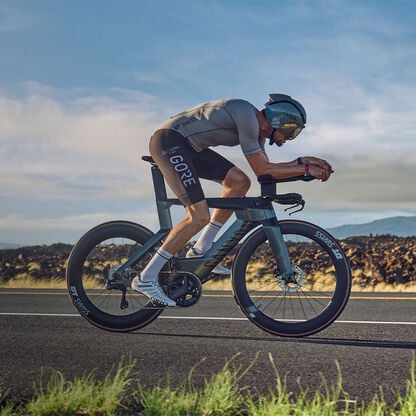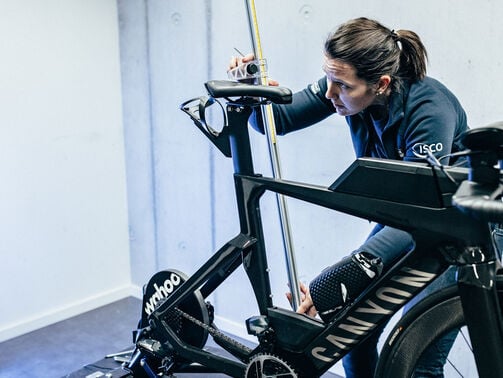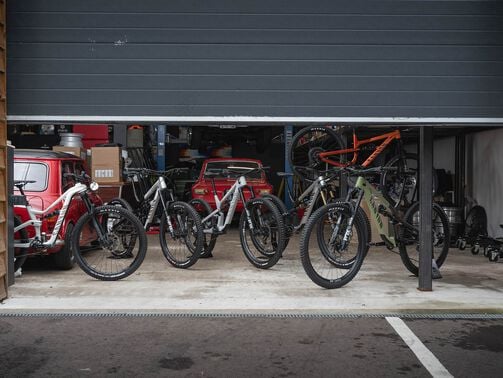Road bike vs mountain bike: Finding your perfect bike match
Want to dominate the singletrack or reign over the road? Here’s how to decide between a new mountain or road bike.

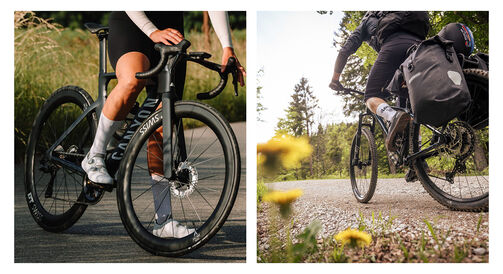
The first dilemma for bicycling newcomers is almost always whether to buy a road or mountain bike. Both offer the same sense of freedom – exploring new roads and trails with the wind flowing through your helmet vents – but completely different experiences. So, which one is best for you?
Contents
Why choose a road bike?
A road bike is designed to swiftly roll over paved surfaces. At Canyon we design our road bikes to be extremely lightweight, with aerodynamic frames that help you ride as fast and efficiently as possible. Our bikes are ridden to victory by professionals in races like the Tour de France, and by amateur riders in local race series and fast-paced group rides the world over. These bikes provide excellent cardio and strength benefits for riders of all skill and activity levels.
So, what do road bikes truly excel at?
- Long-distance rides: A road bike’s low weight and aerodynamic profile help you ride longer distances at speed. An endurance road bike like the Endurace is also designed to be quick and lightweight, yet more comfortable - a trait that’s vital for riders who love long rides.
- Speed and racing: A bike like the Ultimate or Aeroad is designed with speed in mind. This is the bike you want to be riding when competing in your local race series or against other competitive-minded riders in your weekly group ride.
- Fitness training: Trying to lose weight or stay fit? Long-distance rides at a quick pace are a nearly unbeatable workout. It’s also fun to track how much faster you’re getting from week to week.
- Conquering hills and mountains: A long, paved road up a mountain pass can be nirvana for a road cyclist. It may not be easy, but the sense of accomplishment you feel at the top is absolutely unrivaled.
Why choose a mountain bike?
Mountain bikes are beefier than road bikes, for good reason. Rough dirt trails, rock gardens, fallen logs, and exposed tree roots require a sturdy frame and wide tires. Whether you’re a rider who prefers fast-paced rides on technical terrain or a thrill-seeker wanting steep, speedy downhills, we make mountain bikes designed to excel in nearly every environment.
So what do mountain bikes truly excel at?
- Adventure riding and touring: Sturdy mountain bikes with proper gearing and suspension, such as the Grand Canyon and Neuron, can tackle nearly any road, trail, or mountain. Their more upright pedalling position allows you to ride longer in comfort.
- Fast-paced, cross-country riding: Lightweight mountain bikes, such as the Lux World Cup and Exceed, with shorter wheelbases and steeper head tube angles are designed for quick, snappy handling and excel as cross-country race machines.
- Aggressive trail/downhill riding: Mountain bikes with longer wheelbases and slacker head tube angles, like the Spectral and Torque, provide stable, confident handling on steep and rough terrain.
Key differences in geometry and comfort of road and mountain bikes
Because road and mountain bikes are built for different tasks, their designs differ as well.
We created the Aeroad and Ultimate road bikes for speed and agility on paved roads. Their top tubes are longer and handlebars further offset than a typical mountain bike. This leads to a stretched-out riding position, ensuring you can get into a low, aerodynamic position (wondering how it all comes together? Check out our road bike geometry guide.) Meanwhile, the Endurace places the rider a bit more upright for increased comfort and stability. Though you'll still be able to keep up with your friends on a spirited road ride, an endurance bike is less aerodynamic and not quite as responsive as a traditional racing bike. With the exception of the new aluminium Endurace AllRoad, Canyon uses carbon fiber for all its road bikes, given the material’s light weight and ability to dampen road vibrations.
Canyon offers several different types of mountain bikes, ranging from the all-rounder Neuron to the Strive enduro racer. Modern mountain bike geometry features longer reach and slacker head angles resulting in a riding position that's less aerodynamic, but which greatly increases handling their capability on rough terrain. Besides, aerodynamics are less of a priority for mountain bikers. You may notice that there are more aluminium mountain bike models on offer in Canyon’s line-up than aluminium road models. That’s because a mountain bike’s front and rear suspension soak up all manner of bumps, making the ride more comfortable, even without the pricier carbon frame upgrade.
Geometry matters: Frame length and angles explained
Nearly all bikes share the same elements – a top tube, down tube, seat tube, chain stays, and so on. Those tubes will have different sizes and connect at different angles depending on the type of bike the engineers want to create.
Two measurements worth considering when purchasing a road bike are stack and reach. Stack refers to the vertical height from the bottom bracket to the top of the head tube, while reach is defined by the horizontal distance between the center of the bottom bracket and the head tube. A longer reach means you’re more stretched out on the bike, with your hands moving further forward. A taller stack means a more upright riding position.
Calculated by using your hand positions when gripping the hoods, Canyon’s effective stack and reach numbers translate more accurately into real world feel. Effective stack is the vertical height between the bottom bracket and point where you grip the brake levers, while effective reach is the horizontal distance from the bottom bracket to the point where you grip the brake levers.
In addition to stack and reach, the head tube angle will be one of your primary considerations when buying a new mountain bike. The slacker head tube angle of a Torque Mullet CF 7 (63.5 degrees) or Strive CFR Underdog (63 degrees) helps make the bikes more stable at high speeds, and provides a calmer, more controlled feeling on steep descents. You’ll find a steeper head tube angle on the Exceed CF 5 (69 degrees), which is ideal for snappy, precise handling on cross-country trails.
Wheelbase length is also very important; shorter wheelbases make a bike more nimble and playful, while a longer wheelbase increases stability. Canyon’s Ultimate CF SLX 8 Di2 road bike (988 mm, Size M) and Exceed CF 5 mountain bike (1,123 mm, Size M) both have shorter wheelbases than the Endurace CF SLX 7 Di2 (993 mm, Size M) and Neuron CF 8 (1,203 mm, Size M), respectively. This allows you to have more control when you’re in a crowded group of riders in your local criterium on the Ultimate or blasting through tight and twisty, terrain while pedalling the Exceed.
Rider posture: Aerodynamics vs. stability
Generally, road bikes will have riders leaning low over the handlebars for better aerodynamics, while riders will be more upright on a mountain bike, giving them more controlled steering (in certain situations) as well as more comfort. The mountain bike’s more upright position provides riders with more control on technical descents, while the more stretched out road-bike positioning allows riders to cheat the wind a bit more. The Endurace will get road riders a bit more upright, as will swapping out for a shorter stem.
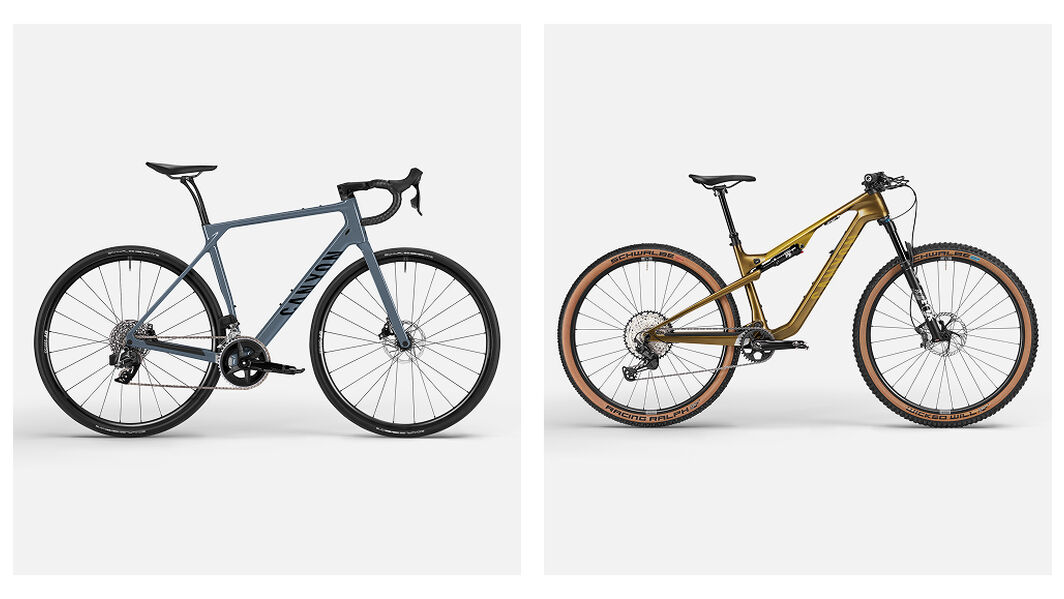
How tires and wheels shape your ride experience
Your tires are your bike’s contact points with the ground and play a huge part in how it moves and handles. Wider tires add stability, while narrow tires cut through the wind better, helping your bike cheat the wind. Smooth tires – often called slicks – offer less rolling resistance, thereby increasing your speed, while knobby tires dig into the dirt, giving you better traction at the cost of speed.
Road vs. MTB tires – narrow for speed, wide for confidence
Years ago, most experts thought the skinnier the road bike tire, the better. Many pros rode on 19 mm skinnies for their entire career. But between research proving the benefits of wider tires and technological advancements like disc brakes, most road bikes now come with 25 mm or even 28 mm tires standard.
Mountain bikes have wider tires, usually between 2- and 2.5-inches. The wider the tire, the bigger the contact patch with the ground, giving the rider more stability and comfort. Unfortunately, the wider tires are almost always heavier and offer more rolling resistance, slowing you down. That’s why most speed-focused cross-country bikes come standard with the narrower widths, while trail, enduro and downhill bikes typically are equipped with wider tires.
Tire pressure and traction: Speed on the road, grip on the trail
For both road and mountain bikes, the lower the pressure, the softer and more stable the ride. High pressure means less contact patch with the ground, lessening the rolling resistance and resulting in faster speeds and a stiffer ride.
- High pressure benefits: Best for fast-paced rides on pristine roads or trails.
- Low pressure benefits: Ideal for increased traction – especially in wet or icy conditions – and comfort on rough terrain.
- Pressure adjustments: PSI can be adjusted mid-ride using a small handpump or inflator.
For more detailed advice, check out our road bike tyre pressure guide and mountain bike tire pressure guide.
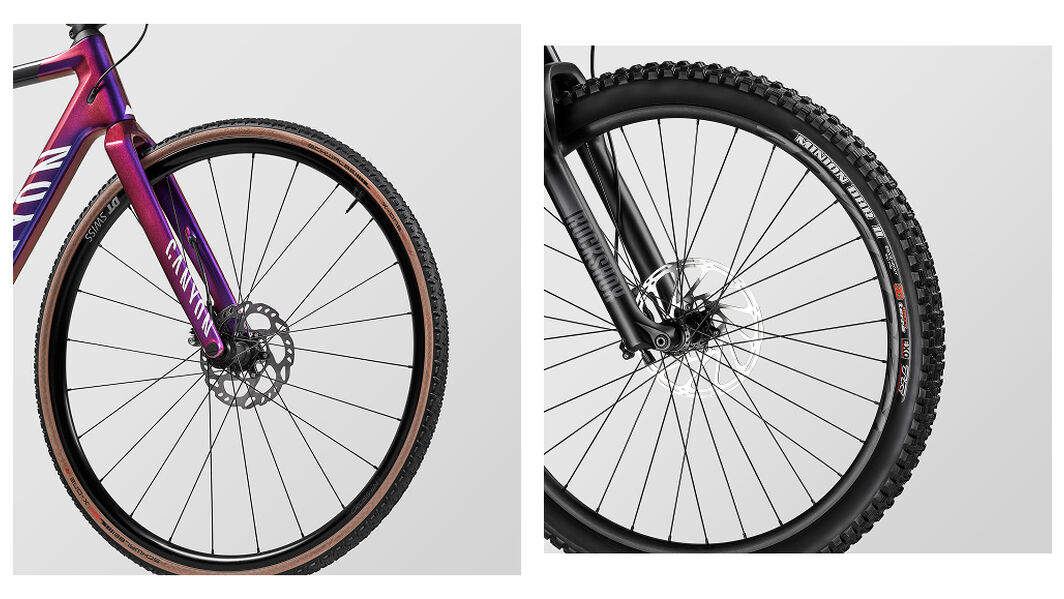
From gears to brakes: Essentials for road and mountain biking
The frame’s design is only part of what makes a road or mountain bike; the drivetrain, tires, and suspension choices truly make the bike.
Drivetrain differences between road and mountain bikes
The world is your oyster when it comes to road bike gearing. It's almost entirely customizable if you want it to be. Since gearing is part of a bike’s overall drivetrain and groupset, you can learn more about the full setup in our road bike groupset guide. Most road bikes come with two chainrings (often annotated as 2-by) and a front derailleur to switch between the two. Typical chainring sizes are 53T/39T, 52T/36T and 50T/34T.
On the rear wheel, you'll find a cassette with 11 or 12 sprockets (referred to as 11- or 12-speed). The most common cassette is 11-28T but a lot of riders in hilly areas opt for a bigger cassette with easier gears for steep climbs. Pro cyclists have the power to run bigger chainrings and smaller cassettes (a higher gear ratio) than amateur and recreational riders. Most everyday roadies will run a compact setup consisting of 50/34 chainrings and an 11-28T cassette.
Mountain-bike gearing is much simpler compared to road bikes, usually with just one small chainring at the front (1-by setup.) This reduces the risk of the chain dropping off when it's bouncing around on rough trails or jostled by obstacles. It also reduces the need for a front derailleur, which means one less component to maintain. If you’d like to learn more about this setup, check out our guide to 1x12 MTB drivetrains.
In order to pedal up steep climbs without the benefit of a second, smaller front chainring, the cassette at the back of a MTB is usually huge. Affectionately referred to as a "dinner plate" due to its size, rear sprockets can be up to 50T or bigger. Most mountain bike cassettes are 11- or 12-speed. The jumps between gears are more noticeable than on a typical road cassette, since a MTB 1x cassette needs to provide a very wide gear range within the spread of just 11 or 12 cassette cogs. For an overview of all components that make up a mountain bike’s drivetrain, see our MTB groupsets guide.
How brake systems differ on road and mountain bikes
Not so long ago, road bikes almost exclusively came equipped with rim brakes. Though they're lighter than disc brakes, rim brakes offered significantly less braking power (especially in wet weather) than disc brakes. As a result, most bike manufacturers now choose disc brakes for all their newer road models. You can learn more about the pros and cons of each in our rim vs. disc brakes guide.
Mountain bikes require disc brakes due to the high stopping power required on gnarly trails. They also often have much bigger rotors for strong performance in wet conditions.
- Road rim brakes: It’s rare finding brand-new bikes with rim brakes today, but for more than a century, that was the only option for riders. Rim brakes are lightweight and offer decent stopping power, but wet conditions make them less reliable. As of 2025, Canyon doesn’t sell a performance rim-brake road bike.
- Road disc brakes: Disc brakes have taken over the road cycling world (and nearly every other cycling discipline) and are now considered the gold standard when it comes to stopping power in all conditions.
- Mountain disc brakes: In addition to stopping power, hydraulic disc brakes offer the precise control needed to slow just enough before diving into a tight corner or to come to a sudden stop on steep terrain. All of our mountain bikes come equipped with disc brakes.
Suspension and rigid setups on road and mountain bikes
Road bikes are ridden on smooth, paved roads, so suspension is typically overkill on road bikes, adding unnecessary weight to an otherwise featherweight bike for no good reason.
Though fully-rigid mountain bike were common at the dawn of the sport, most MTBs today have some form of suspension to soften the hard terrain beneath the wheels. It's also useful if you're attempting big jumps and drops.
Hardtail mountain bikes just have suspension forks. This means their rear triangle is fixed. MTBs like the Grand Canyon and Exceed are cross-country hardtails and much lighter than most full suspension mountain bikes. Front suspension travel on a hardtail varies between 100 and 140 mm.
Full suspension mountain bikes feature both a suspension fork and rear suspension. Having both ensures a more comfortable ride and better handling on technical trails, but also can impose a weight penalty. Suspension travel varies from 100 mm to as much as as 200 mm, meaning there's a full-suspension rig out there for wherever and however you're riding.
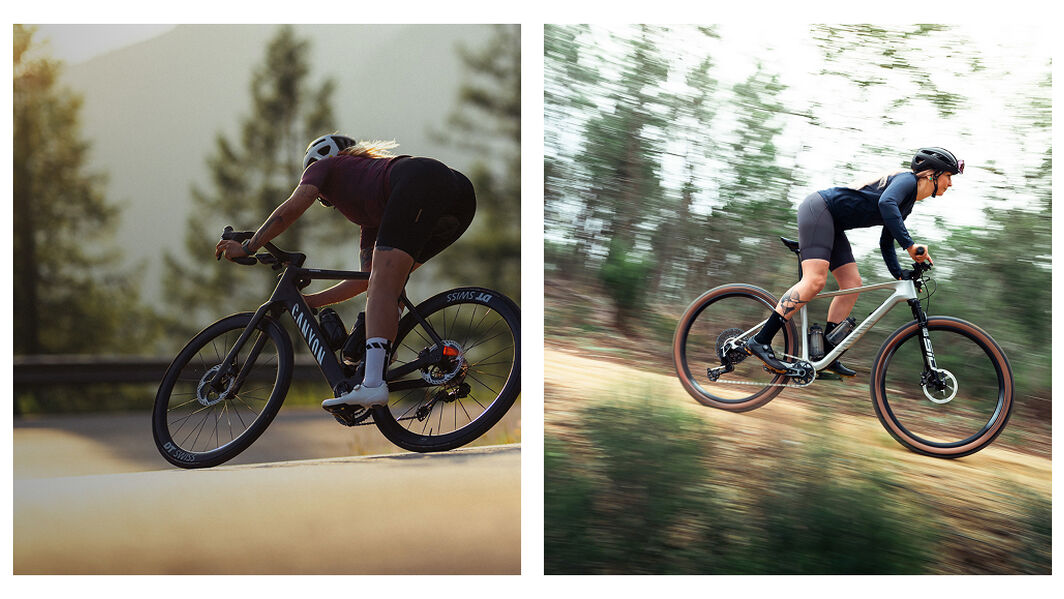
Road bikes vs mountain bikes: Terrain and performance
Road bikes and mountain bikes are built with different terrain in mind, but that doesn’t mean they can’t cross over from time to time. Whether you’re wondering if your MTB can hold its own on the tarmac, if your road bike can handle a dirt path, or if you can tweak your setup to bridge the gap, here’s what you need to know before you ride.
Can mountain bikes be used on roads?
You can ride a mountain bike on pavement, but don’t expect to win a sprint against your buddy on a road bike. Some of my favorite singletrack requires a short road ride to get to the next section.
Can you ride a road bike on trails?
In the lead-up to cyclocross season, a former teammate would detour us off the pavement and onto some mild dirt trails on our road bikes. We both ran fairly wide tires (for road bikes) and knew those trails were devoid of too many roots or rocks. Riding a road bike on more serious singletrack could be a recipe for disaster though. Keep road bikes on the pavement! If you want to ride a drop bar bike off road, consider buying a gravel bike—some of which also feature front suspension.
Can I convert my mountain bike to be more road-friendly?
You can swap out your knobby tires for a smoother pair, reducing road resistance. Some serious racers will attach aero extensions to their handlebars during long-distance events that traverse long stretches of pavement. Don’t expect to keep up with riders on a dedicated road bike though.
Final thoughts: Pros and cons of road bikes and mountain bikes
Now you know the differences between the bikes, let's see where they really come into their own and where they fall short.
Pros and cons of road bikes
| Pros | Cons |
|---|---|
| Lighter | Harder to control when wet or slippery |
| Easier to maintain | Rough roads are less comfortable |
| Faster | You’ll often ride among traffic |
| Multiple uses such as weekend rides and commuting | |
| Great for long-distance rides |
Pros and cons of mountain bikes
| Pros | Cons |
|---|---|
| Access remote and wild countryside | More maintenance required on brakes and suspension |
| More comfortable riding position | Slow on roads due to tires’ rolling resistance and lower gearing |
| Easier to ride on different terrain such as gravel, mud, and sand | You may need a vehicle to access distant trails and bike parks |
| Great for learning technical skills |
How to choose the bike that’s right for you?
Now that we’ve compared road bikes and mountain bikes, we hope we’ve made your decision a little easier. For one final tip, we recommend looking at the terrain around you. What are the roads like? Are the trails more tantalising? Do you have nearby forests or trail centres? Are you keen to tick off some mountain passes from your bucket list?
Knowing where you think you can have the most fun is a crucial part of riding a bike. We’re confident you’ll find a Canyon bike you’ll enjoy whether it’s a road bike or a mountain bike. If you still have trouble deciding between the two, there is a third option. Designed for true adventure riding, the Grizl is a gravel bike built light-yet-tough, capable of tackling the most difficult roads and trails. It’s not the fastest bicycle you’ll ever pedal on the road, but it does bridge the road and mountain bike worlds effectively.
If you’re still deciding, explore our road bike buying guide and mountain bike buying guide for more detailed advice. You can also use our bike comparison tool to see models side by side.
Once you narrow down your choices, check Canyon’s events pages and social media channels for information about test rides in your area. If you still can’t decide, try taking each for a test ride at one of Canyon’s experience centres found across the world, such as the one in Carlsbad, California or München, Germany. Feel like you’d be happier on a different model after a few rides? Easily exchange your purchase with Canyon’s generous 30-day return policy.
Discover our Gravel Bikes
Discover our Road Bikes
Did this article help?
Thank you for your feedback
-
 About the author
About the authorRobert Annis
Robert Annis is an award-winning outdoor-travel journalist. As an experienced writer and sport enthusiast he writes content that is inspiring with focus on road biking. You might have read Robert's articles in Bicycling, National Geographic, Outside, Travel + Leisure, Inside Hook, AARP, Midwest Living, Sierra, Hemispheres, Departures, Lonely Planet, Afar, Los Angeles Times, Chicago Tribune, RV Magazine, and Hidden Compass.





